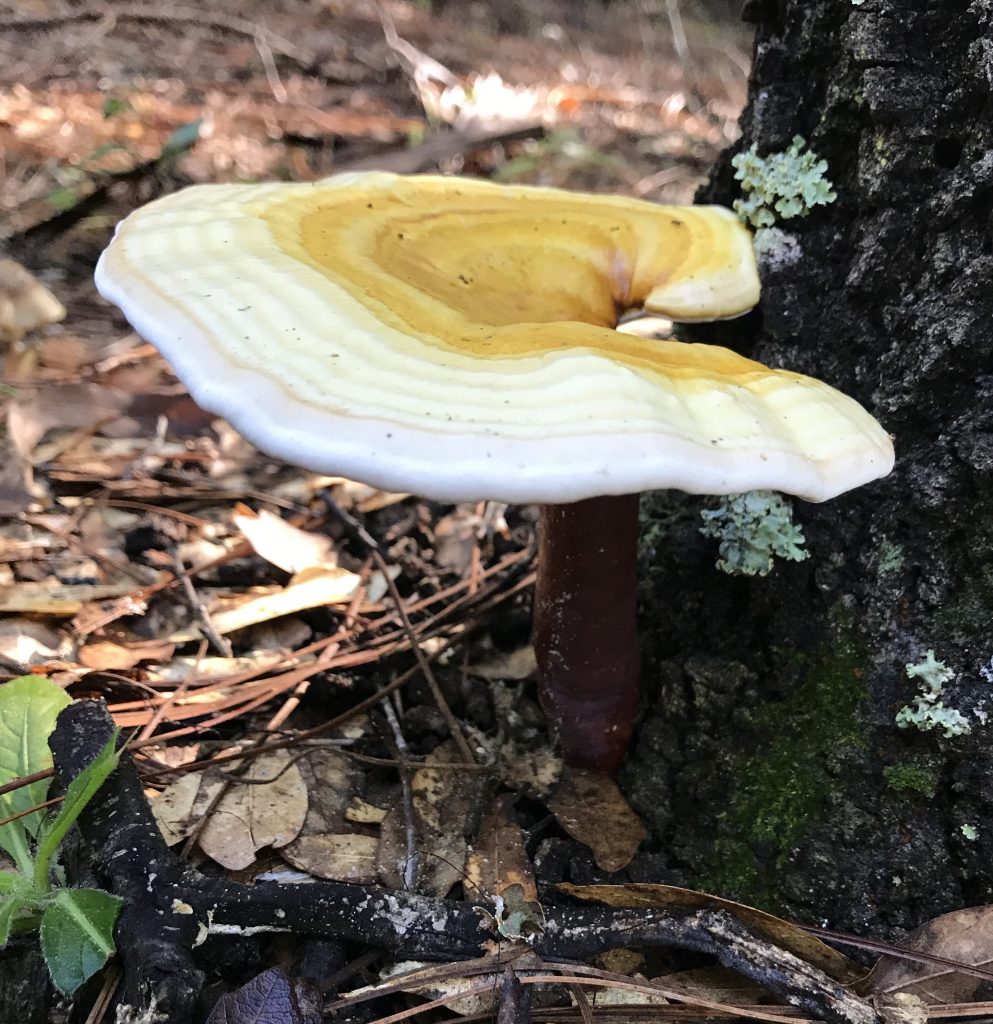
We have several species Reishi mushrooms in North American. This one is Ganoderma curtisii if growing on oaks, G. meredithiae if growing on pines. Photo by Green Deane
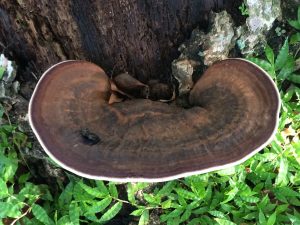
Ganoderma lobatum. Photo by Green Deane
The question isn’t whether Reishi mushrooms grow in North America. The question is what to call them. Some would argue there are only six species of Reishi mushrooms on this continent. Others say many more. Just as the botanical world is in DNA flux so to is the fungal realm. Regardless of the species the Reishis are all Ganodermas, a genus name that that always suffers from translation. One sees Ganoderma translated as “shiny skin.” That’s not exactly right. In Greek it actually means “polished leather.” When I think of shiny skin I think of what my fingers and toes looked like after getting chilblains or frost bite. My skin was shiny. It did not look like polished leather. By the way once you get chilblains you always have them. I can go into a well air-conditioned building in Florida and my fingers and toes will ache from frozen nights spent ice skating 60 years ago.
Pictured on top is Ganoderma curtisii, an easy to identify Reishi mushroom. It’s almost always shaped like a P, or a golf club, some say a cobra. All the ones I have spied have been growing on oaks. In 1988 it was decided that a slightly different species grows on Pines especially in the Gulf Coast states. That is G. meredithiae name for fungal expert Meredith May Blackwell. As for use my herbalist friends tell me our Reishi mushrooms can be used like their more famous Asian relatives and do stimulate the immune system. Consult your local herbalist for details.
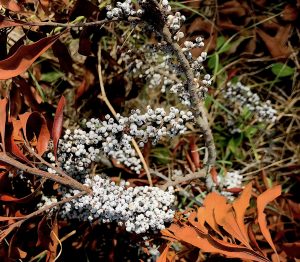
Southern Wax Myrtle berries. Photo by Green Deane
Humans often see beauty in dead plants from bouquets to Christmas wreaths. A woods road’s trimming in offered us an unusual view of Southern Wax Myrtle berries. Light gray they often hide in the green aromatic leaves of this shrub. However when the trimmed leaves browned it revealed the concealed berries. They can be used as a spice when dried and put in a pepper mill. And if you have a lot of them (and the need) they also produce a green wax. If you mix that wax with one quarter tallow it makes a smokeless candle that keeps away biting insects. That chandle, however, is a lot of work. But, if it is all you have to drive away insects it’s much worth it.

Classes are held rain or shine or cold. (Hurricanes are an exception.) Photo by Kelly Fagan.
Foraging classes this weekend should not be interrupted by weather. The week after is more iffy and perhaps two storms are on the way. Note my Sunday class is in a new location near Jacksonville.
Saturday, October 3rd, Mead Garden, 1500 S. Denning Dr. Winter Park, FL 32789. 9 a.m. to noon, meet by the bathrooms. Note this is Mead Garden just northeast of Orlando. Not Ft. Mead which is 90 miles further south. Also the entrance to Mead Garden is on the west side on S. Denning Drive, Winter Park. Some GPS programs put the entrance on the east side on S. Pennsylvania Avenue, Winter Park. That entrance was decades ago.
Sunday, October 4th, Tide Views Preserve, 1 Begonia Street, Atlantic Beach Fl 32233 (near Jacksonville Fl.) 9 a.m. to noon. Meet near the main bathrooms. 9 a.m. to noon. There is no charge for this class but donations will be accepted. The reason is this it’s an exploratory class at a new location. Let’s find out what’s there together.
Saturday, October 10th, Eagle Park Lake, 1800 Keene Road, Largo, FL 33771. Meet at the pavilion near the dog park. 9 a.m. to noon. This is presuming the weather will cooperate. We might be ducking Gulf-of-Mexico storms that weekend.
Sunday, October 11th. Shall we try an end-of-the-season mushroom class? Mushrooms are as fickle as the weather so whether we will find any is luck of the draw. Long-range weather forecasts say will could have a lot of rain between now and then so who knows. Maybe there will be a late-season flush. We should at least find some to study. This class is taught with Joshua Buchanan and the fee for this particular class is $10 per adult. Time 9 a.m. to noon. Location: 8515 Markham Road, Lake Mary Fl. 32746. There’s ample parking, drinking water, and rest rooms. Do not bring mushroom baskets. If you are going to collect (for study of course) put them in a back pack or bag or the like. If you have any questions email me: GreenDeane@gmail.com.
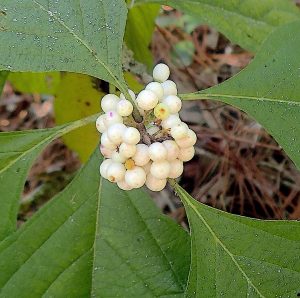
White Beautyberries. Photo by Green Deane
Are the berries to the left edible or not? Ninety-nine plus percent of white berries are not edible. White berries are a huge warning flag saying stay away. But there are exceptions. I can think of a few wild white berry species in the world that are edible, some in North America and one in Africa. But what of the berries pictured left? They are white American Beautyberries. Usually they are magenta when ripe. These are stark white. I have eaten a few. They taste like the colored ones. A few years ago I had a woman in New Jersey write to me and report she eats them all the time and makes jelly out of them. That’s not an official endorsement but it is about as close as one can get to knowing if they are edible. There are at least four species of Beautyberries that can spontaneously produce white berries, and there might be a man-made cultivar or two. The shrub at left had magenta colored berries for several years then went one for one year then back to colored berries. To read more about them click here.
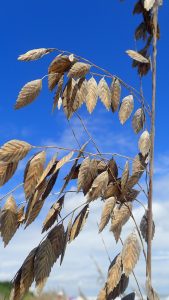
Sea Oats. Photo by Green Deane
The grain pictured right, Uniola paniculata, is edible though it does not produce a lot of seed. It is also protected. It’s not protected because it is rare. In fact it’s very common. But the plant’s roots helps keep Florida’s coastal dunes in place thus Sea Oats are protected. I have known some folks to grow Sea Oats in their backyard as a long-lived perennial grass. They are very drought tolerant and highly regarded by browsing animals such as deer but are lowly regarded by grazing animals such as cows. As Sea Oats are protected you might want to find a similar looking relative in the forests of Florida. They are called… Wood Oats… not too imaginative. Wood Oats are edible as well and not protected. Use them as you would cultivated oats. They are easy to identify: They look like Sea Oats just in the wrong place. To read about Sea Oats click here.
Our timing Sataurday was perfect. The husks of the Coastal Ground Cherry were gold to a tan, dry, papery. Inside the fruit was deep yellow to gold, tangy in taste. Ground cherries, in this case Physalis angustifolia, ripen from green to gold, getting sweeter and tangier as they go along. But they can often have a bitter after taste either from being under ripe or some species just retain some bitterness. A little aftertaste of bitterness is okay but the best is when there is none. Thus one always tastes a ripe ground cherry then waits a minute or so for any bitterness to appear.
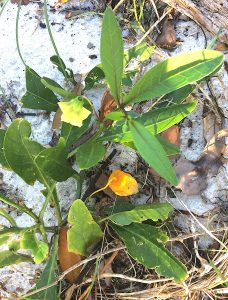
As the Ground Cherry ripens the husk turns golden. Photo by Green Deane
While locally Ground Cherries can fruit nearly all year, they do produce a spring and fall crop. In cooler climes they just have one season ripening in late summer and fall. Here our fall crop tends to be better than our spring one. Spring ground cherries can rot on the plant or get damaged by insects and that is also when I tend to find more bitter ones. But this time of year brings out the best in ground cherries. One can find whole, undamaged, very ripe Ground Cherries in significant numbers. You can make a pie out of them if you can manage to get some home uneaten. Incidentally there is a second local ground cherry that resembles the Coastal Ground Cherry. It’s Physalis walteri, also known as starry-hair ground-cherry and sand cherry. It has star-shaped hairs on the lower edges of the leaf which are visible with a hand lens. Still edible, however. To read more about Ground Cherries go here.
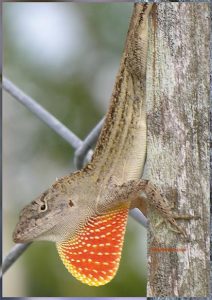
Cuban Anole
The smallest roundup ever happened during one of my classes in Winter Park. At the end of all my classes we always relax and chat a bit. I happened to mention that the invasive, aggressive Cuban anoles taste like bacon (when deep fried.) That led to how to catch them and I told of one student who would make a noose out of panic grass and lasso them. One of the people at the class agreed that was how to do and fashioned a noose for other students to use. Three of them went searching and one actually managed to catch an anole with a grass loop. Truth is stranger than fiction. To read about cooking them go here. You also might want to read: Ignite of the Iguana.
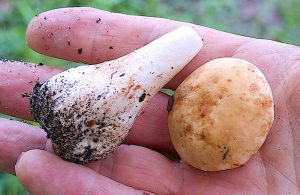
Chestnut Bolete. Photo by Green Deane
One of my favorite mushroom has had a name change, the Chestnut Bolete. It was Gyroporus castaneus the latter meaning chestnut. This worked well as the top of the bolete is often chestnut colored. The fungal powers that be have decided the name Gyroporus castaneus can only be used for the European bolete. Those mushrooms called Gyroporus castaneus in the northern part of North America are now Gyroporus borealis. Those called Gyroporus castaneus in southern North America are now Gyroporus smithii. (Too bad Brownii wasn’t in the offering.) The genus name is from two Greek words that mean “round pores” as the mushroom does not have gills. There is no “eye” sound in Greek thus they never would say the other name for a hero sandwich gyro. They would not call the mushroom “gye-ROPE-poor-us.” They say: “year-ROPE-poor-us,” or, “year-row-POOR-us.” Castaneus is “cass-TAN-ee-us.” Borealis is boor-ree-AL-us. Smithii is SMITH-ee-eye. The Boletes are a user-friendly group to study. There are no deadly ones if you’re in good health or ones that cause lasting organ damage should one err. Some can make you quite ill but you will live (unless your health is already compromised some way.)

Green Deane videos are now available on a USB.
Changing foraging videos: My nine-DVD set of 135 videos has been selling for seven years and are still available. They are the same videos I have on You Tube. Some people like to have a separate copy. A second option is a16-gig USB that has those 135 videos plus 15 more. While the videos can be run from the DVDs the videos on the USB have to be copied to your computer to play. They are MP4 files. The150-video USB is $99 and the 135-video DVD set is now $99. The DVDs will be sold until they run out then will be exclusively replaced by the USB. This is a change I’ve been trying to make for several years. So if you have been wanting the 135-video DVD set order it now as the price is reduced and the supply limited. Or you can order the USB. My headache is getting my WordPress Order page changed to reflect these changes. We’ve been working on it for several weeks. However, if you want to order now either the USB or the DVD set make a $99 “donation” using the link at the bottom of this page or here. That order form provides me with your address, the amount — $99 — tells me it is not a donation and in the note say if you want the DVD set or the USB.

Green Deane Forum
Want to identify a plant? Perhaps you’re looking for a foraging reference? You might have a UFO, an Unidentified Flowering Object, you want identified. On the Green Deane Forum we — including Green Deane and others from around the world — chat about foraging all year. And it’s not just about warm-weather plants or just North American flora. Many nations share common weeds so there’s a lot to talk. There’s also more than weeds. The reference section has information for foraging around the world. There are also articles on food preservation, and forgotten skills from making bows to fermenting food. This is weekly newsletter #425, If you want to subscribe to this free newsletter you can find the sign-up form in the menu at the top of the page.
To donate to the Green Deane Newsletter click here.

